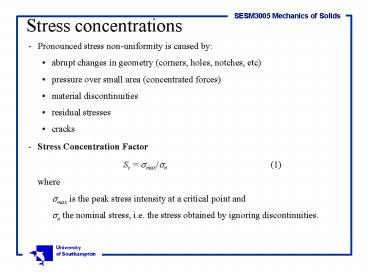Stress concentrations - PowerPoint PPT Presentation
1 / 20
Title:
Stress concentrations
Description:
abrupt changes in geometry (corners, holes, notches, etc) ... for cavities in the shape of oblate spheroids, formed by rotating ellipse about ... – PowerPoint PPT presentation
Number of Views:2016
Avg rating:3.0/5.0
Title: Stress concentrations
1
Stress concentrations
- Pronounced stress non-uniformity is caused by
- abrupt changes in geometry (corners, holes,
notches, etc) - pressure over small area (concentrated forces)
- material discontinuities
- residual stresses
- cracks
- Stress Concentration Factor
- Sc smax/sn (1)
- where
- smax is the peak stress intensity at a critical
point and - sn the nominal stress, i.e. the stress obtained
by ignoring discontinuities.
2
Stress concentrations
- Methods for determining Sc
- Analytical, exact or approximate (numerical
experimental), assuming elastic behaviour, giving
the calculated Scc - Experimental, accounting for material
characteristics and the nature of loading
(particularly fatigue), giving the effective Sce - Example fatigue experiment with perfect and
notched specimens
3
Stress concentrations
- Two-Dimensional Elasticity
- Theoretical predictions of stress concentration
factors can be made by applying the
two-dimensional theory of elasticity - (i) Equations of equilibrium
Introducing Airy's stress function F, the
equations above are identically satisfied if the
stresses are given by
4
Stress concentrations - Two-Dimensional Elasticity
- (ii) Strain-stress relations
- In the case of thin solids (plates), it is
assumed that sxz syz szz 0. This is the
state of plane stress
In the case of thick or wide solids, it is
assumed that gxz gyz ezz 0. This is the
state of plane strain
5
Stress concentrations - Two-Dimensional Elasticity
- (iii) Compatibility Condition
In terms of Airys stress function, the above
condition is written
In polar/cylindrical co-ordinates
6
Stress concentrations
- Concentrated load on free edge of half-plane
- The stress function in this case is given by
The stresses are obtained in polar co-ordinates.
srr constant along circle with diameter d, srr ?
? as d ? 0
7
Stress concentrations
- Hole in infinite plate under uniaxial tension s
- Stresses relative to a polar frame of reference
From the above solution, Scc 3.
8
Stress concentrations
- Hole in a plate of finite width under uniaxial
tension s
k is the ratio of strip width to hole diameter
sn is the average stress over the weakened
cross-section
9
Stress concentrations Elliptic hole
- Solution obtained using complex potentials and
elliptic (orthogonal curvilinear) coordinates a
and b defined by
Given a pair (a, b), the position of a point on
the x-y plane is specified as the intersection of
an ellipse
and a hyperbola
10
Stress concentrations Elliptic hole
- Constant c is chosen so that the ellipse for a
particular value of co-ordinate a a0 coincides
with a hole with major semi-axis a and minor
semi-axis b. - The hole is described by the equation
Constants a0 and c are given in terms of a and b
11
Stress concentrations Elliptic hole
- Along the hole boundary (a a0), saa 0,
- f angle between the major axis and the
direction of loading - Normal stress in the b (tangential) direction
12
Stress concentrations Elliptic hole
- Infinite plate in the direction of the minor axis
(f p/2)
The maximum value of the right-hand side is
obtained for b 0 and b p
where r is the radius of curvature at the ends
of the major axis. As b/a ? 0, sbb ? ? but then
the hole becomes a crack and the problem is
considered in the context of Linear Elastic
Fracture Mechanics (LEFM)
13
Stress concentrations Elliptic hole
Shear in the directions of major and minor axes
Equivalent state of stress uniform tension s t
at f p/4 and uniform compression s t at f
p /4. Then
14
Stress concentrations Elliptic hole
- Any state of plane stress
- The principal stresses s1, s2 and their
directions are determined. - If f1 is the angle between the major axis and the
first principal direction, sbb found for s1, f1
and s2, f2 f1 p/2 are superposed. - It is possible to find the maximum value of sbb
and the angle b at which it occurs numerically.
15
Stress concentrations - cavities
- Cavity shown on the right prolate spheroid
(rugby ball), formed by rotating ellipse about
its major axis. - Exact solutions obtained for an infinite solid
(a, b ltlt overall dimensions) - Scc given as a function of a/b
- For a sphere (a/b 1) Scc 2.05
- Similar data available for cavities in the shape
of oblate spheroids, formed by rotating ellipse
about its minor axis (door knob)
16
Flat bar with two grooves in tension
- Approximate formulae
- Shallow groove (t ltlt b)
- Deep groove t O(b)
- Groove of intermediate depth
17
Neubers diagram
18
Neubers diagram
19
Combined loading
- Stress concentrations may be the result of
various loads acting together. If the stress they
produce is of the same type, e.g. normal stress
in the same direction, then the principle of
superposition can be applied to evaluate the
total maximum stress developing locally. - Example circular shaft with an axisymmetric
groove under both tension and bending (see Boresi
Schmidt, p. 580). Both these loads cause
nominal axial stresses sn(P) and sn(M),
respectively. At the root of the groove, these
stresses become Scc(P)sn(P) and Scc(M)sn(M),
respectively. Applying superposition, the maximum
stress at that point is found from - smax Scc(P)sn(P) Scc(M)sn(M)
20
Combined loading
- If the shaft is also subjected to a torque T, the
maximum shear due to local stress concentration
is found from - tmax Scc(T)tn(T)
- Yield failure is then assessed by introducing
smax, tmax to either von Mises or Tresca yield
criterion.

